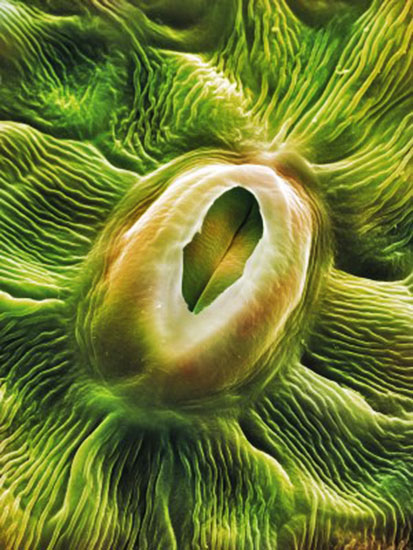|
Plants regulate important processes such as photosynthesis through pores called 'stomata'.
Credit:
Power and Syred/SPL
The food writer Michael Pollan, author of The Omnivore's Dilemma (2006) among others, wrote an article in The New Yorker in 2013 exploring why terms such as,
His thesis boils down to a divide in biology that allows zoologists to use anthropomorphic terms, but denies the privilege to plant scientists.
Pollan allies himself with a small band of intrepid researchers crusading against the "cerebrocentric" view that permits behavior only to organisms with brains.
He tells of collateral
damage from sensationalist treatments that exaggerate plant-science
findings, and of glimmers of a new sensitivity towards all life.
The idea that plants are 'smarter' than their immobility suggests is now supported by rigorous experimentation and fieldwork that are uncovering the genes and chemicals that mediate plants' environmental intelligence.
We know now that much of a plant's rich behavioral repertoire is hard to observe because it is played out in a chemical arena. Plants overcome the constraints of immobility mainly by harnessing their prowess as synthetic organic chemists.
For instance,
Much of the relevant literature is now synthesized in three books by leading researchers in the field:
Between the eighteenth and the twentieth centuries, Erasmus Darwin, Charles Darwin and botanists Wilhelm Pfeffer and Jagadish Chandra Bose published books that brim with observations on plant behavior.
Charles Darwin's 1880 The Power of Movement in Plants, for instance, incorporates insights from his experiments on how exposure to light drives bending in grasses, which laid the foundation for the discovery of the hormones responsible for plant movement.
If they were alive today,
these scientists would wonder what all the fuss is about.
He ushered in the modern era of chemical ecology, including an exuberance of theory to explain these metabolites' patterns of accumulation.
Much of the theorizing came from zoologists, who applied paradigms from animal-behavior studies to plants, often without deeper understanding of how plants function as organisms.
The plant-biology community had little patience for this, being at the time focused on understanding mechanisms of plant growth under controlled laboratory conditions, developing Arabidopsis as a model plant and embracing molecular biology.
After reading Farmer,
Karban and Trewavas's books, I felt that the prevailing scientific
opinion that plants are mere autotrophic growth machines has perhaps
as much to do with the divorce between molecular and organismic
approaches as with the botany-zoology divide.
Because leaves dominate most plants' above-ground biomass, herbivores usually home in on them, a circumstance that has shaped leaves' chemistry, physics, morphology and development.
Plants, meanwhile, 'eat'
sunlight with their leaves. So to fathom leaf evolution, it is
important to understand both herbivores' digestive tracts and the
dynamics of solar radiation.
Farmer's book was written before his laboratory reported a landmark discovery:
Farmer weaves his compelling narrative from hard-core molecular research on mechanisms of perception of herbivore attack and defence responses, to more speculative inferences about how leaf color and escape to rocky outcrops help plants to survive the relentless interests of herbivores.
He highlights the lack of evidence for some sensationalist stories of plant-plant signaling, such as one about signaling between South African acacia trees about impending attacks from antelopes.
And of the three books, Leaf Defence is the only one to include structures of plant chemicals.
In Plant Sensing and Communication, Karban, a behavioral ecologist and entomologist, discusses environmental elements to which plants are thought to respond, such as light and sound.
Karban, who featured prominently in Pollan's article, largely avoids political melodrama, instead providing clear working definitions of some of the contentious vocabulary:
His summaries of plants' sensory abilities - such as the cues and signals that they use to adjust to the environment - retain an evolutionary perspective.
And he branches out into
areas such as mate choice, for example detailing how plants
selectively breed with specific fathers represented in a mixed
pollen load.
Charles Darwin systematically investigated plant behavior in the late nineteenth century.
Credit: GraphicaArtis/Corbis
Although he is a gifted writer and synthesizer, Karban's review of the research on the mechanisms of plant perception and response is not well served by his lack of familiarity with the techniques that uncover them.
Issues that he identifies as central unsolved problems (such as whether the volatile 'alarm calls' of plants protect against herbivores and increase fitness under real-world conditions) have been solved and published.
The unrealistic experimental designs so common in the early literature are frequently reported uncritically.
In discussing the complicated process of demonstrating an adaptation, Karban does not mention the genes responsible for the expression of traits such as shade avoidance, or the advantages offered in this area by cheap sequencing.
So I recommend Plant
Sensing and Communication to those who want a low-calorie
introduction and a deeper consideration of the concepts, but the
primary literature is better for understanding the mechanisms.
Plant Behavior and Intelligence is a wild ride, covering ground from the origins of life to intelligent nutrient-foraging behavior in the roots of higher plants.
Trewavas's five decades of research into plants' molecular biology and physiology, and their evolution as self-organizing systems, make him fully 'phytomorphized'.
He thinks like a plant, effortlessly calling on specific traits to look at how plants solve problems in similar ways to social insects - from siphonogamy (in which pollen tubes carry sperm cells to egg cells) to highly dispersed sensory systems.
He celebrates behavior in
plants while avoiding "animal envy". At 76, Trewavas may have
written his last book - but it is one that encapsulates his life's
work beautifully.
Trewavas and Farmer share a deep understanding of how plants function, mechanistically and biochemically, and this anchors their forays into how plants work in the real world.
This grounding in mechanism may prove to be the key
to convincing a scientific community sensitized to the gap between
populist hype and the data on plant behavior.
Researchers need to understand the natural-history context of such models before plant behaviors can be sensibly scrutinized in the functional (natural) context.
The infusion of ideas from behavioral ecology between 1950 and 1990 revived the field, but it now needs balance.
The mental constructs that ecologists bring to experimentation on plant function, such as the cost-benefit paradigm applied to resource allocation, are of limited value when they are unmoored from the mechanisms that anchor these phenotypes.
These
three books suggest that the way forward may be through a return to
the observational skills that allowed the great researchers of the
twentieth century to become phytomorphized.
|



